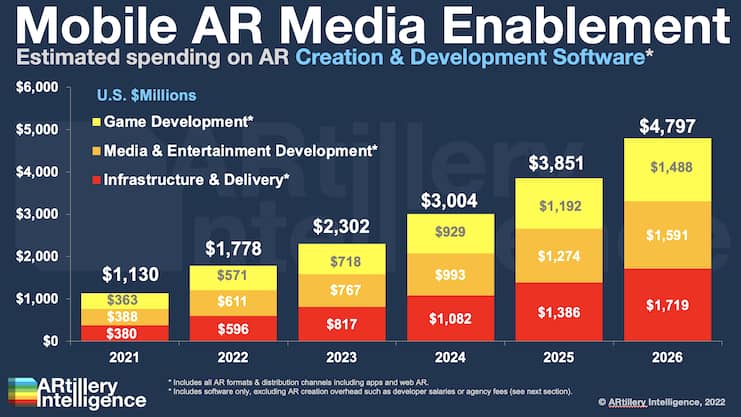
Like many analyst firms, market sizing is one of the ongoing practices of AR Insider’s research arm ARtillery Intelligence. A few times per year, it goes into isolation and buries itself deep in financial modeling. The latest such exercise zeroes in on mobile AR revenues.
This takes the insights and observations accumulated throughout the year and synthesizes them into hard numbers for spatial computing (see methodology and inclusions/exclusions). It’s all about an extensive forecast model coupled with rigor in assembling reliable inputs.
So what did the latest forecast uncover? At a high level, global mobile AR revenue is projected to grow from $12.45 billion in 2021 to $36.26 billion in 2026, a 23.8 percent CAGR. This sum consists of mobile AR consumer and enterprise spending and their revenue subsegments.
Drilling down, our latest Behind the Numbers installment looks specifically at mobile AR marketing and advertising. How much is spent on software that helps consumer brands and media companies create and distribute AR experiences? We’re talking games, media, and entertainment.
Picks & Shovels
Jumping right into the numbers, global mobile AR media & games enablement revenue is projected to grow from $1.13 billion in 2021 to $4.8 billion in 2026. This is a 33.5 percent compound annual growth rate, and represents one of AR’s most opportune subsectors.
As for how this spending breaks down, it includes gaming ($1.48 billion by 2026), media & entertainment ($1.59 billion by 2026), and infrastructure and delivery ($1.72 billion by 2026). Software that enables AR advertising and marketing is measured separately.
Boiling it down, the above software spending categories have one thing in common: enabling enterprises or developers to create consumer-facing AR. Buyers of this technology (software license or SaaS) include developers and brands that develop AR for their customers.
This makes spending on AR media and games enablement fall into a category we call B2B2C. It will continue to develop as an opportune AR revenue category, as it represents the proverbial “picks and shovels” that democratize advanced AR experience creation and distribution.
These enablement functions will grow in demand as AR itself does, because they lower barriers to creation and accelerate time to market. This includes AR experience creation platforms such as Niantic Lightship, as well as AR workflow or optimization players like VNTANA.

Table Stakes
AR enablement software is also driven by, and correlated to, the growing population of AR developers and creatives, which will reach an estimated 4.89 million by 2026. This includes a global base of creative pros that could convert to AR, given low-friction tools such as Adobe Aero.
As AR continues to become “table stakes” among brand marketers, this base of AR creative pros will migrate to the medium like osmosis. Beyond hands-on developers and creators, brand marketing departments and ad agencies will increasingly adopt and license AR platforms.
This trend will benefit all AR enablement tools outlined above, but one area we’re particularly bullish on is web AR. The streamlined use case and relative lack of activation energy (e.g., downloading apps) could make web AR pull ahead as a go-to modality for AR development.
We’ll pause there and circle back in the next Behind the Numbers installment to drill down on another spatial computing subsegment.

